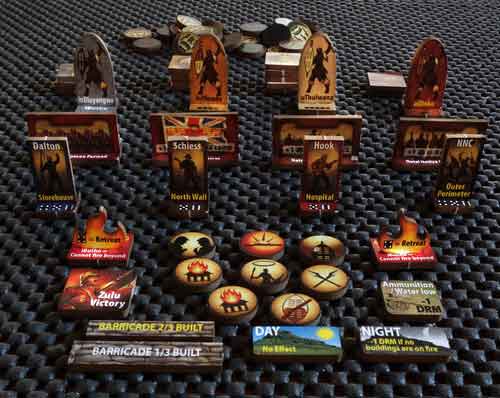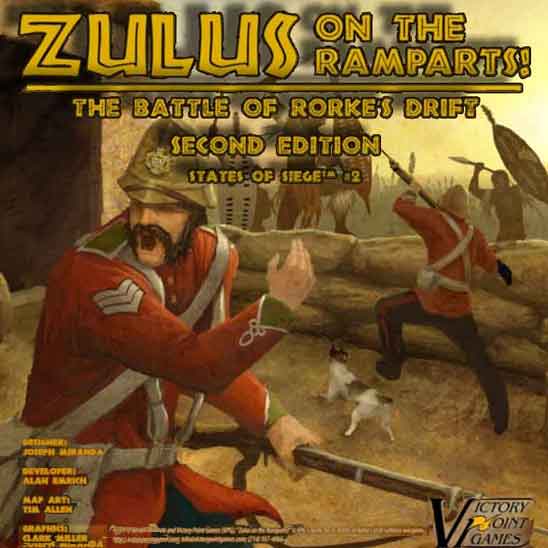Zulus on the Ramparts! is a board game of the category wargame inspired by Rorke’s Drift in 1879. The player assumes the role of the 140 British soldiers who faced more than 4,000 African soldiers in the legendary siege in which the first were incredibly to finally retire victorious enemy. No tokens representing the army of His Majesty only a deck of cards and some markers. Yes Zulu regiments are represented by several chips symbolizing the four main formations attacked Rorke’s Drift and “life points”.
On the map we see represented the missionary position and four “ways” to move toward him. These “pathways” oval divided into five cells each representing the advance of the Zulu regiments. If any of them reaches the red square that is the “Victoria Zulu” tab, the game is over for the player, who has failed to repeat the heroic historical result.
The record of Zulu victory begins in the red box with a 0, but may be delayed by the player up to two positions, making it harder to reach their target Zulus. In other parts of the map are in certain markers and letters reporting things like water scarcity and ammunition, the arrival of the night, forming a reserve platoon or building defenses now.

Before starting the game, we put in a bowl a series of round tiles that represent both the progress of the various Zulu regiments as various events. We must also prepare before starting the deck in a specific way, leaving from the last 4 cards (shuffled at random) of relief column that ends the game (if you have not done before) and inserting the letter Night (hampering the fight) to about half of the deck.
First thing we do each turn is, remove one of the fas of the container and make it effective: execute the corresponding event in the case of one of these or, in the case of an advance (most likely) will move the number of spaces the corresponding Regiment (iButho) Zulu.
If you still survives then the player performs the main phase of action, where you can choose from several options: forming the reserve squad, trying to put out fires, build a barricade, distribute ammunition and water, shoot / melee attack heroes and draw cards. The latter represent the official historical fence and give the player important assets and greater flexibility and can often “sacrificed” in exchange for decisive action. The player usually has a five-card hand that is renewed at the end of the day. These letters will or will these heroes who have seen or bursts of gunfire. Heroes can also shoot or use special skills stronger and be used for various actions on the board as the platoon booking form or build the barricade. For all these latest features, normally we should have “fallen” hero to the table with a prior action.

The shooting and fighting are made by rolling dice. According to the letter we use, we can pull a number of dice (typically between 1 and 5) depending on the distance at which the Zulu regiment are. 6 eliminate a life point of the enemy formation (having from 2 to 5 points); May 1 will be withdrawn the box back.
Once selected and implemented the action, the player ends his turn by drawing a card from the deck if you like, and removing (dropping) a hero.
The game may end in several ways: the most common is the Zulu entering the enclosure, as already in advance, meaning that the player has lost. Alternatively, remove all English Zulu regiments. The third way to finish the game is when the “Column relief” letter is at the end of the deck appears. At that time, the player has points that may have been gathered or lose based on a scale to determine which side has won and his margin of victory (may be less, epic, tie, etc).
| Features | |
| Game Type | Strategy, Wargame |
| Recommended Age | +12 years |
| Language | English |
| Players | 1 Player |
| Game Time | 25-35 minutes |
| Difficulty | Medium |
| Boardgamegeek | www.boardgamegeek.com/boardgame/41627/ |
